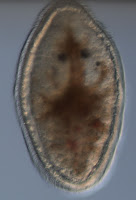On May 3rd and 4th 2012, I performed plankton tows at the South Cove of Cape Arago, near Charleston, OR as the tide was coming in. I placed a 153μm plankton net into a channel of water flowing between smooth rocks. In this manner I was able to obtain interesting samples, which included, among other things, many specimens of Müller’s larva pictured here.
Johannes Müller (1801-1858), a German physiologist and the inventor of the plankton net, first described larval forms of many phyla including Platyhelminthes, or flatworms, whose planktonic larvae retain his name (Smith et al. 2002). The term “Müller’s larva” is used to describe planktonic larvae in the Polycladida order of the class Turbellaria. Müller’s larva is ciliated and characterized by several paired and unpaired lobes (left). The lobes bear cilia that are longer than cilia on the rest of the body. At the anterior (up) and posterior (down) end of the larva there are tufts of longer cilia (apical and caudal, respectively). The apical tuft originates from the apical organ, a sensory structure that is associated with the central nervous system (Rawlinson 2010).
When I collected these larvae they were fairly uniform in size approximately 180 μm long by 80 μm wide. Their shape was simliar, with lobes present in all of the specimens. When I observed them two weeks later some had lost their characteristic lobes. The second photo shows a larva where the lobes are present, but do not protrude much. Müller’s larvae may also have several pairs of eyes. The two areas of black pigmentation at the anterior portion are a cerebral eye and an epidermal eye, which is closer to the apical tuft.
The last photo (left) shows a, presumably, more advanced larva that has completely resorbed its lobes and has begun to take the characteristic shape of an adult flatworm. In this larva you can clearly see the two cerebral eyes, with one of the epidermal eyes lower and to the right. When observed two weeks later this larva had not noticeably changed in shape or form. Little is known about the development of Müller’s larva, and it would be interesting to investigate the mechanisms driving these morphological changes.
Smith NF, Johnson KB and Young CY. 2002. Platyhelminthes. In: Atlas of Marine Invertebrate Larvae. Edited by C. M. Young. Academic Press. New York.
Rawlinson KA. 2010. Embryonic and post-embryonic development of the polyclad flatworm Maritigrella crozieri; implications for the evolution of spiralian history traits. Frontiers in Zoology. 7:12





No comments:
Post a Comment